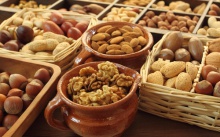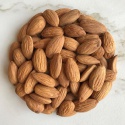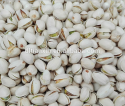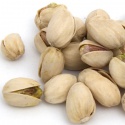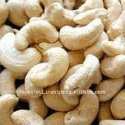Walnut
The growing demand for walnuts revived the California market. The current harvest of 670 thousand tons against 600 thousand tons last year led to a drop in prices. Thanks to the huge demand from India, Turkey and the Middle East, the California industry quickly returned to a comfortable position - in recent weeks, prices have risen by at least 10%. Walnuts In shell and 80% of LHP are becoming scarce.
The product from Eastern Europe does not compete with products from the US because of its poor quality. In recent weeks, some activity has been seen in the Eastern European market, but customers from Europe are cautious about this material. Producers in Eastern Europe buy walnuts in shell in Chile, and then clean them at processing plants. The first lots of products will appear in Europe by the end of May.
The last two weeks the Chilean market of walnut without a shell is stable. Most likely, the reduction of tension will be felt on later deliveries in June-July. Buyers took high prices for the walnut harvest in 2017, as the spot market in Europe is empty, especially for the ones without the shell of manual peeling. This situation arose because of the poor quality of the Chilean harvest last year, resulting in buyers opting out of the supply. In the new season, Chile needs to realize about 90 thousand tons, and there is a possibility of an early reduction in prices.
Cashew
The cashew market is like a roller coaster. Unexpectedly, the discount for cashew nuts is announced, as there is no demand, buyers are gradually making orders, and prices immediately increase by a couple of cents. In the sphere of raw cashews (RCN), volatility triumphs - the mood is constantly changing under the influence of numerous rumors.
And rumors (in part the facts) are as follows:
• In West Africa, a good cashew harvest is expected, with the leadership of Côte d'Ivoire and a yield of 800,000 tons of RCN. In fact, the cashew harvest in Côte d'Ivoire has suffered from rains and will be smaller and lower in quality.
• Cashew in Guinea-Bissau has matured for 3-4 weeks ahead of schedule, so supplies will begin in April-May - a fact.
• Prices for RCN in various African countries have slightly decreased and stabilized - a fact.
• The situation with cashews in Vietnam and Cambodia is controversial in terms of size and quality. Definitely, the harvest will be less than last year, and the quality of RCN in some areas raises fears - a fact. In the short term, this will negatively affect the loadings of processing factories, which will operate at full capacity, when RCN shipments from West Africa will reach significant volumes - a fact.
• Prices for cashews fluctuate depending on demand - a fact.
• Most customers closed their needs until May and will return to the market in June.
• Most buyers hope for price cuts in June-July - a fact (however it is not known whether this will happen).
Given the rumors/facts, it can be assumed that prices will remain high longer due to problems with crops in Vietnam and Cambodia. It is likely that the prices for cashew will go down in the second half of 2017, when enough RCN from West Africa will arrive in India and Vietnam, accounting for ~ 40% of the world production. It is unlikely that the price of cashew WW 320 will fall below the US $8.8 per kg. It is necessary to focus on the range of 9.15-9.90 US dollars per kg. It is recommended to cover cashews until June / August, and then wait patiently for late deliveries.
Macadamia
Macadamia nuts of a new crop in South Africa come to the processing factories. The new crop looks better than last year, but it is unlikely to be above 50 thousand tons.
In Australia, the cyclone Debbie collapsed, and some areas producing the nut suffered. Rains caused by the cyclone can make harvesting difficult, and the yield losses of macadamia can reach 8-10%. Be patient and wait for a couple of weeks until this information is confirmed.
The unrelenting demand for all sizes of macadamia nuts led to an increase in prices, especially for the first supplies of macadamia of the new crop.
Significant demand for macadamia in shell from China exerts pressure on farmers and exporters and forces increased sales. At the moment, the demand for Chinese macadamia (mainly in shell) is growing. In this country, there is a need to create a good supply chain of walnut without a shell, as the world production of macadamia will grow significantly in the next decade, which will require the search for new customers and access to new markets.
Brazil nut
The Brazilian walnut crop (perhaps due to El Niño) created big problems for producers, sellers, and buyers. Today this is no longer a matter of price, but a question of availability. Buyers are wondering why the collectors do not go far into the jungle, but the problem this year is different - the fruits simply did not form. The total deficit of the Brazil nut will last until December 2017-January 2018, when the new crop enters the market.
Prices for Brazil nuts vary between $14.8 and $16.5 per kilo. This year's proposal for Brazil nuts will be extremely limited, this season it is worth to switch to other.
Pecan
Prices for pecans without shell are relatively stable. Pecan in shell harvest in the US is sold and shipped to China or to processors. It is unlikely that the situation in the pecan market will change before the new harvest begins - not earlier than July-August. Halves of small sizes become scarce. The time from the receipt of the order to the shipment is 4-6 weeks. The US food industry purchases and uses a large amount of this type of nuts.
The pecan harvest in South Africa will enter the market in June-July. Due to heavy rains, some varieties can expect quality problems. The bulk of the pecans in the new harvest shell (over 90%) will be exported to China. The remaining part after peeling will remain on the domestic level.
Hazelnut
The situation in the Turkish hazelnut market has been stable recently. For sale, the nuts of the 2015 harvest are still being offered. The difference in prices for “old” and “new” is gradually increasing. There are numerous reports about good species for a new crop, and buyers' interest is centered on current and new crops (to avoid risks with quality problems that are unavoidable for the product of the 2015 harvest). The new harvest is delayed for at least 3 weeks, and this is good, as the possible danger of frosts decreases. It is recommended to monitor the situation and avoid orders with long positions.
Almond
Weather conditions in California are favorable for positive forecasts regarding a new almond harvest. The spot market reacted with a slight decrease in prices. It is expected that the situation will remain relatively stable in the coming weeks. The first official estimates of the National Agricultural Statistics Service of the US Department of Agriculture about the size of the crop in 2017 will appear on May 11.

